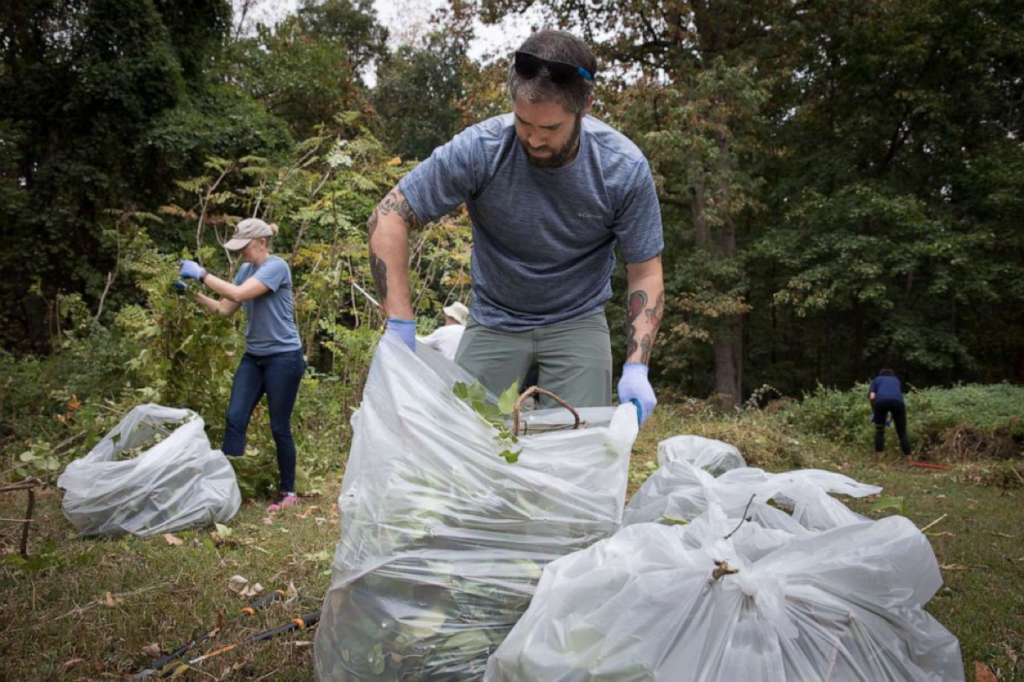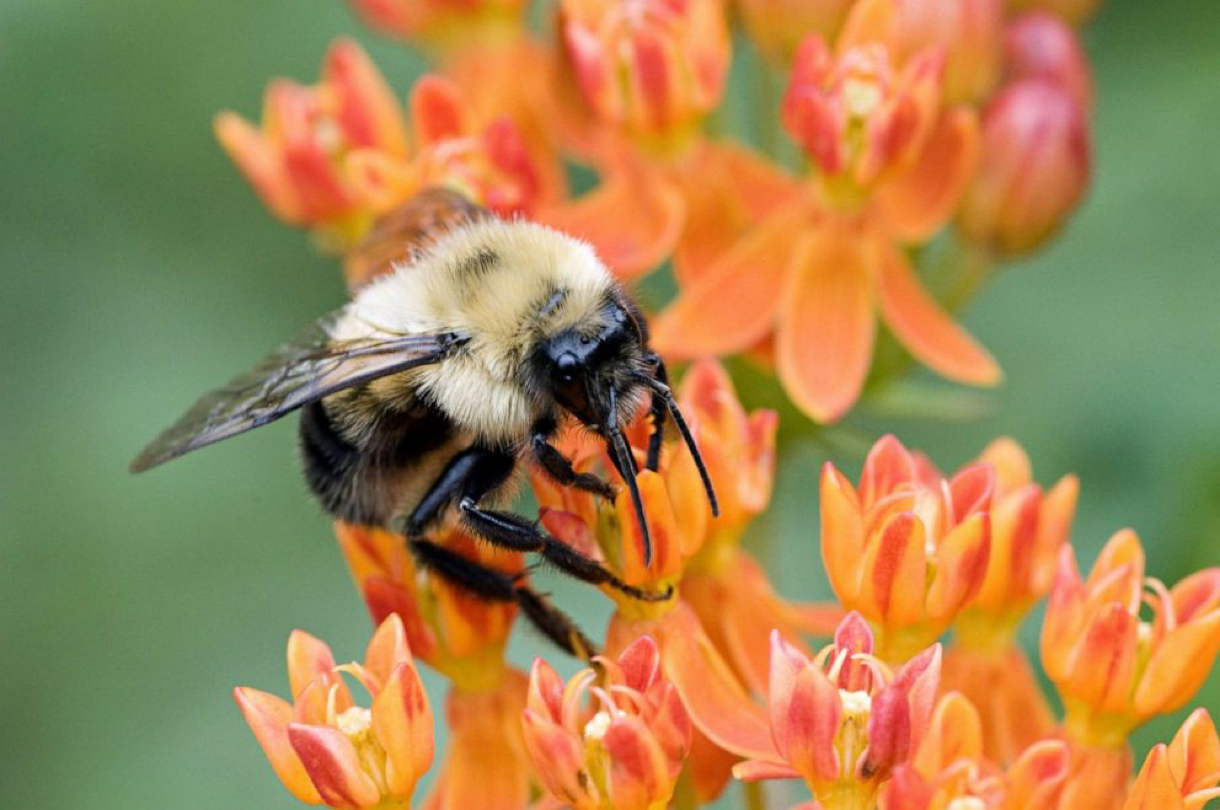Bumblebees are some of our most effective pollinators, but more than one-quarter of the species is facing extinction.
Bees, butterflies and other pollinators are under threat by habitat loss, pesticides, disease and climate change.
Bees sustain our lives in ways we sometimes fail to recognize. They are as an essential part of our food web — from blueberries to pumpkins — and even play a role in growing the cotton used in much of our clothing.
European honeybees that farmers bring in to pollinate crops have suffered from colony collapse disorder and parasites. While 15% of the world’s food is pollinated by them, nearly 80% is pollinated by native bees and other wildlife, according to the U.S. Fish and Wildlife Service. Honeybee keepers can rebuild their colonies, but bumblebees and other native species need our help.
MORE: Nearly 40% decline in honeybee population last winter ‘unsustainable,’ experts say
As our primary pollinators, bees efficiently collect and transport pollen from plant to plant. Butterflies, moths, beetles ants and some birds and bats also help move pollen accidentally but are no match for the efficiency of bees. There are 3,600 species of native bees in the United States and an estimated 20,000 species worldwide, according to the Xerces Society. Currently, only the Rusty Patched bumblebee is listed as endangered. There are simply too many other species to track in order to protect in this way.
Here’s how you can help:
Avoid pesticides
Neonicotinoids and other systemic pesticides are devastating to bees and butterflies. In Oregon, more than 50,000 bumblebees died after a group of trees were sprayed with the pesticide.
These types of systemic chemicals can poison wildlife for years after their use. Avoid using weed killers and other insecticides on your lawn or your garden. Ask your local nursery if they use neonicotinoids and shop at ones that practice organic or integrated pest management. Share plants with like-minded neighbors, or grow plants from untreated seeds. Nature centers, local native plants sales and native nurseries are also good sources of pesticide-free plants.
Plant native plants
Like monarchs, which only feed and lay eggs on milkweeds, many bees feed on certain plants that they’ve adapted to over millions of years.
Provide food via nectar- and pollen-producing plants with regionally specific species. Aim to have three different plants blooming from early spring through late fall. Different bee species feed at different times, and many can only reach the nectar and pollen from certain types of flowers.
Plant diversity supports bee diversity. Many cultivated plants are sterile and produce no pollen or nectar for bees. Like the monarch, many butterfly and moth species lay eggs on specific plants, so include host plants for species native to your area. Even a balcony or small patio with pots of blooming natives will help.
To find information about native plants in your area, contact your state native plant society or search by your zip code on the National Wildlife Foundation’s Native plant finder or at the Audobon Society.
Provide nesting sites
Don’t be too neat and tidy. Most native bees are solitary — they don’t make hives and rarely ever sting, so you don’t have to worry about inviting them into your yard. About 70% are ground-nesting, so leave some areas of bare soil, especially if you see them emerging from small holes in the ground. Lawns, mulch and pavement reduce the amount of available nesting sites.
Cavity nesters make up the other 30%, and they use hollow-stemmed plants and other woody plants to overwinter and lay eggs. Help them by creating brush piles if you have a discreet spot, and don’t clean up your dead perennials and other woody plants until late spring. Insect hotels, which have recently become popular, require careful maintenance to avoid spreading pathogens, so a safer alternative are plant stems that have died and other naturally occurring woody material. Beetles and other insects hide under leaves, so “leaving the leaves” in the fall, is another way to help insects survive winter.
Remove Invasives
Non-native plants can become invasive, taking over habitats that support pollinators. Invasives can kill trees and move into forested land, out-competing native species. Non-native plants support very few insects and create food deserts for insects, birds and wildlife. You can find lists of invasive species at the Invasive Plant Atlas of the U.S.
Reduce your lawn
Lawn grass isn’t native and does little to support insects or other wildlife — and it’s frequently the target of harmful chemicals. Gardens with trees, shrubs, native grasses and perennials are a much better for the bees and the environment. Try not to mow early in the spring where seasons change. A recent study in Appleton, Wisconsin, dubbed “No Mow May,” determined that lawns that weren’t mowed that month showed fives times greater bee abundance and three times as many bee species compared with regularly mowed areas.

Spread the word
Put up a sign announcing your pollinator habitat. Tell your neighbors and/or ask your homeowners association to participate. Ask your local nursery to stock pesticide-free native plants for pollinators. Stay informed and support local, state and national efforts. Have your town or campus join Bee City USA or take the Pollinator Protection Pledge at the Xerces Society.
“Every little bit helps,” said renowned entomologist Doug Tallamy, who has extensively studied relationships among plants and insects.

“Our preserves and national parks are not adequate to prevent the predicted loss of species, and we have run out of the space required to make them big enough,” he wrote in his new book, “Nature’s Best Hope.” “If Americans replanted half of their lawns with native plants, shrubs and trees, we would have more wildlife habitat than all the national parks combined.”
Plant a square yard of native plants or fill a few pots on your balcony or stoop and you’ll be amazed who shows up.
For more information: Xerces Society




